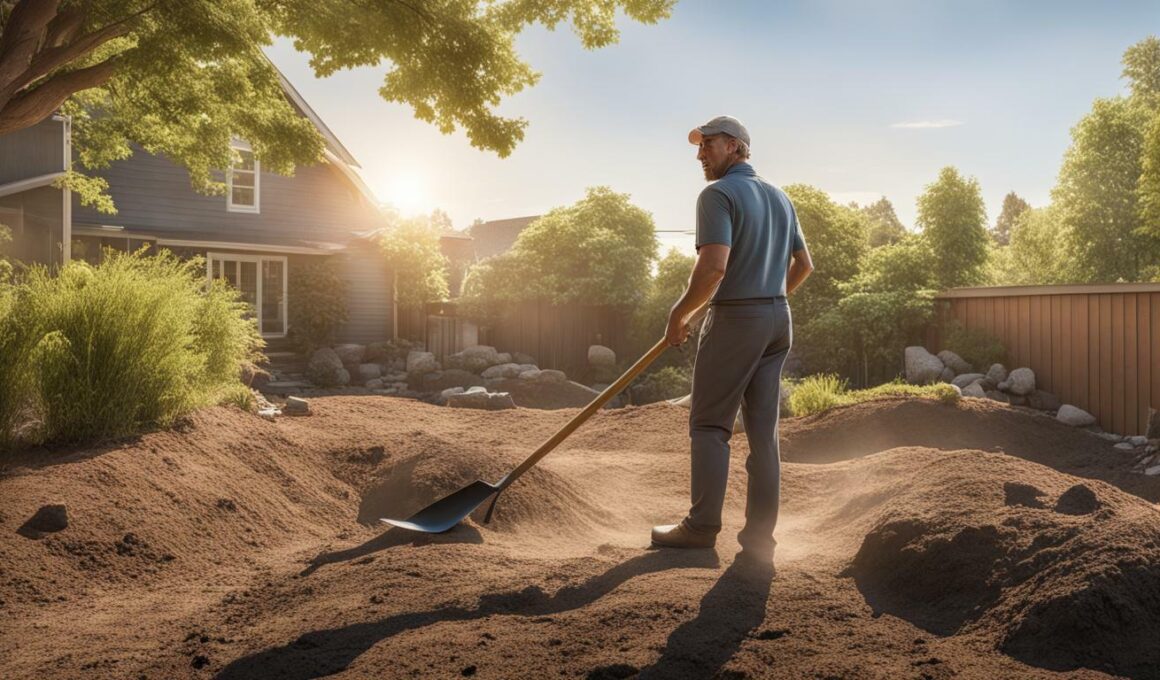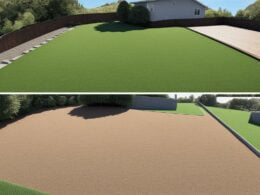Having an uneven backyard can make it difficult to enjoy outdoor activities and can even be a hazard. Luckily, leveling your backyard dirt is a simple and affordable solution that can transform your outdoor space into a safe and welcoming environment. In this article, we’ll provide you with easy steps to level your backyard dirt on your own and achieve a perfectly leveled yard.
Key Takeaways
- Leveling backyard dirt is important for easier maintenance and better aesthetics.
- Leveling ensures a safe and stable surface, prevents water pooling, and improves drainage.
Why Leveling Backyard Dirt Matters
Are you tired of dealing with a bumpy and uneven yard? Leveling backyard dirt is an essential step towards creating a beautiful outdoor space that is easy to maintain. Here’s why:
| Reason | Description |
|---|---|
| Prevents Water Pooling | Uneven areas in your yard can cause water to collect in certain spots, which can lead to flooding and damage to your lawn or garden. Leveling the dirt promotes proper drainage and prevents water from stagnating. |
| Improves Drainage | Proper drainage is crucial to maintaining a healthy lawn or garden. By leveling your backyard dirt, you can ensure that water flows away from your home and garden beds, preventing water-logging and soil erosion. |
| Creates a Safe and Stable Surface | Uneven and bumpy ground poses a hazard to anyone walking, running, or playing in the yard. By leveling your yard, you can create a safe and stable surface that is suitable for all types of activities. |
Identifying uneven areas in your yard is the first step towards leveling it. Look out for areas where water collects, depressions in the yard, and bumps and humps in the ground. These areas can be fixed with the right tools and techniques.
Why Leveling Backyard Dirt Matters: Tips to Keep in Mind
Remember that unlevel ground can impact your entire landscape. Uneven ground can cause your lawn to dry out in some areas while making other areas waterlogged. It can also make your garden beds look messy and unorganized. So take the time to level your backyard dirt and reap the benefits of a beautiful and functional outdoor space.
Tools and Equipment for Leveling Backyard Dirt
Leveling backyard dirt requires certain tools and equipment to achieve the desired results. Here is a list of essential items you will need:
| Tool/Equipment | Purpose |
|---|---|
| Shovel | To dig up soil and move it around for leveling |
| Rake | To spread soil evenly and break up clumps |
| Wheelbarrow | To transport soil, especially for larger yards |
| Level | To measure the slope and ensure a flat surface |
| Tamper | To compact the soil after leveling |
Additional equipment that may be helpful includes a garden hose or spray paint to mark out the desired grade, a sturdy ladder to reach different areas of the yard, and a tiller or cultivator for more significant leveling projects.
When using these tools, it’s essential to wear appropriate safety gear, such as gloves, closed-toe shoes, and eye protection. This equipment will help you achieve a perfectly leveled yard and give you the outdoor space you desire.
Preparing the Yard for Leveling
Before you start leveling your backyard dirt, it’s important to prepare the area properly. This will ensure that you get the best results and avoid any issues down the line. Here are the steps you need to follow:
Remove Obstacles and Debris
The first step is to clear the area of any obstacles or debris. This includes rocks, tree stumps, and anything else that could interfere with the leveling process. Use a shovel or rake to remove any surface debris and dispose of it properly.
Mark the Desired Grade
Next, mark the desired grade for your yard. This will help you ensure that you’re leveling your yard to the right height. Use stakes and string to mark the boundaries of your yard and any areas that need to be raised or lowered.
Address Underlying Issues
If your yard has poor soil quality or drainage problems, it’s important to address these issues before you start leveling. For example, you may need to add topsoil to improve the soil quality or install drainage pipes to improve drainage. Be sure to address any underlying issues before you start leveling.
Consider Landscaping Techniques
If you’re leveling your yard for landscaping purposes, there are certain techniques you can use to create gentle slopes or terraces. This can help add visual interest to your yard while also improving the overall functionality. Consider these techniques before you start leveling.
Leveling Backyard Dirt: Step-by-Step Guide
Now that you’ve prepared your yard, it’s time to start leveling your backyard dirt. Follow these easy steps to achieve a perfectly leveled yard:
- Start small: Don’t try to tackle the entire yard at once. Start with a small area and work your way gradually.
- Remove excess dirt: Use a shovel to remove any excess dirt from the area you want to level. Make sure to dispose of it properly.
- Check the grade: Use a level to check the grade of the area. If it’s not level, use a rake to distribute the dirt evenly.
- Add topsoil: If necessary, add topsoil to the area to achieve the desired grade. Use a rake to distribute it evenly.
- Compact the soil: Use a tamper or a roller to compact the soil, making sure it’s level and firm.
- Repeat the process: Repeat the above steps for each small section until the entire yard is leveled. Make sure to check the grade of each section before moving on.
- Water the soil: Once you’re done, water the soil thoroughly to help settle it.
Remember, different types of soil may require different techniques, so adjust accordingly. And don’t forget to take your time and be patient – proper leveling takes time and effort, but the result is worth it.
Finishing Touches and Aftercare
Now that you have successfully leveled your backyard dirt, it’s time to add some finishing touches to enhance its aesthetics and ensure proper upkeep. Here are some tips to consider:
1. Edging the Leveled Area
Edging your leveled area is a great way to create a clean and defined boundary between the grass and surrounding landscape features like flower beds or walkways. You can use materials like bricks, stones, or metal edging to achieve this effect. Not only does it improve the look of your lawn, but it also helps to keep the soil in place and prevent erosion.
2. Seeding or Sodding the Lawn
Depending on the state of your lawn before you leveled it, you may need to seed or sod the area to promote healthy grass growth. Follow the appropriate steps for planting grass seed or laying sod, and be sure to water the area regularly to support strong root development.
3. Adding Mulch or Gravel
If you plan to incorporate landscaping elements like flower beds or shrubs, adding mulch or gravel can help to retain moisture and regulate soil temperature. This not only supports healthy plant growth but also adds aesthetic appeal to your outdoor space. Just be sure to consult your local garden center or landscaper to determine the appropriate type and amount of mulch or gravel for your specific needs.
4. Ongoing Maintenance
Aftercare is crucial for maintaining the quality of your leveled backyard dirt. Be sure to water the area regularly, especially during dry spells, and mow the grass at the appropriate height to support healthy growth. You should also monitor the area for any signs of uneven settling and address them promptly to avoid any potential issues down the line.
Common Mistakes to Avoid
When it comes to leveling backyard dirt, there are some common mistakes that people make that can lead to uneven and unsatisfactory results. Here are some mistakes to avoid:
- Not properly compacting the soil: After leveling the soil, it’s important to compact it using a lawn roller or a tamper. If the soil is not compacted, it may settle unevenly over time, creating an uneven surface once again.
- Neglecting drainage issues: If there are drainage issues in your yard, such as water pooling or not draining properly, these issues should be addressed before leveling the soil. Otherwise, the soil may become waterlogged or erode unevenly.
- Rushing the process: It’s important to take your time when leveling the soil and to work in small sections. Rushing the process can lead to mistakes and uneven results.
- Ignoring soil quality: If the soil in your yard is poor quality, it may be difficult to achieve a level surface. Consider adding topsoil or other amendments to improve the soil quality before leveling.
- Not checking for uneven settling: After leveling the soil, it’s important to periodically check for any signs of uneven settling. This can be addressed by adding more soil to low areas or removing soil from high areas.
By avoiding these common mistakes, you can achieve better results when leveling your backyard dirt and create a beautiful and functional outdoor space.
What Are the Expert Tips for Leveling Backyard Dirt?
Leveling your backyard can seem like a daunting task, but with these expert tips, it becomes easier. Start by removing any debris or vegetation. Then, use a shovel to distribute the dirt evenly across the yard, filling in low spots as you go. Compact the soil using a roller or a tamper. Finally, check the level using a long straight-edge or a laser level. By following these steps, you can level your backyard effectively.
Can Leveling Backyard Dirt Help with Sloping Issues in a Yard?
Leveling backyard dirt is a beneficial step in addressing sloping issues in your yard. By using expert tips for sloped backyard landscaping, you can create a more functional and visually appealing outdoor space. Proper leveling can help improve drainage, prevent erosion, and provide a stable foundation for various landscaping projects. It is a crucial first step toward creating an even and usable yard.
Conclusion
Congratulations! You have now learned how to level your backyard dirt like a pro. By following the steps outlined in this article, you can create a beautiful and functional outdoor space that you and your family will enjoy for years to come.
Remember, leveling your backyard dirt is an essential step in maintaining a healthy and safe yard. It can prevent water pooling, improve drainage, and create a stable surface for your outdoor activities.
With the right tools and equipment, preparing your yard for leveling can be easy and stress-free. And once you have completed the leveling process, adding finishing touches such as edging, seeding, and mulching, can give your yard a professional look.
Just be sure to avoid common mistakes such as neglecting to address drainage issues or rushing the process. With a little patience and attention to detail, you can achieve the perfect leveled yard.
So go ahead, start planning your backyard leveling project today and enjoy the benefits of a beautiful and even outdoor space.
FAQ
Q: How long does it take to level backyard dirt?
A: The time it takes to level backyard dirt depends on the size of your yard and the complexity of the project. It can range from a few hours to several days.
Q: Do I need any special skills to level backyard dirt?
A: No, leveling backyard dirt is a DIY-friendly project that anyone can tackle with basic tools and a little patience. Just follow the step-by-step guide provided in this article.
Q: Can I level backyard dirt on my own or do I need professional help?
A: Most backyard dirt leveling projects can be done by homeowners themselves. However, if you have a large or complicated yard, or if you lack the time or physical ability, it may be worth considering hiring a professional.
Q: Are there any alternatives to leveling backyard dirt?
A: If you don’t want to level the whole yard, you can consider adding raised beds or terraces to create a more even surface for specific areas. However, for a completely level yard, the best option is to level the dirt.
Q: Can I level backyard dirt if I have a sloped yard?
A: Yes, it is possible to level backyard dirt on a sloped yard. However, it may require additional steps, such as creating terraces or retaining walls to accommodate the sloped terrain.









